Culture
Navratri Notes: She Flows Like Ganga, Saraswati, And Also Like Oshun Of The Yorubas Of Africa
Aravindan Neelakandan
Oct 07, 2024, 07:30 PM | Updated 07:30 PM IST
Save & read from anywhere!
Bookmark stories for easy access on any device or the Swarajya app.
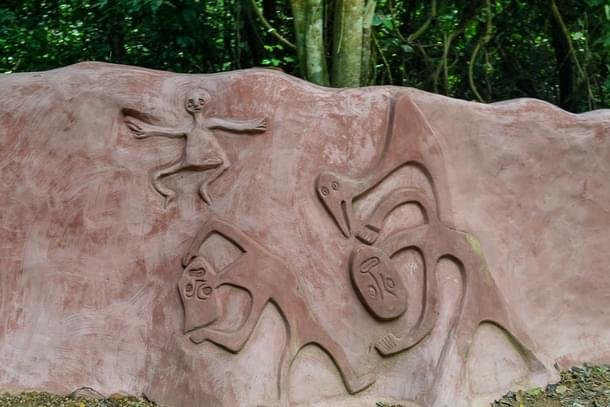

She flows as the river. Nourishing as a mother, She flows. In Her flow, She creates civilisations. In Her furious floods, She destroys. In Her flow She is the Time. Through the Water Cycle, She emphasises the cyclic nature of Time. She also flows through Time. She thus is the memory of all that has flown through Her.
She is the River Goddess in every civilisation.
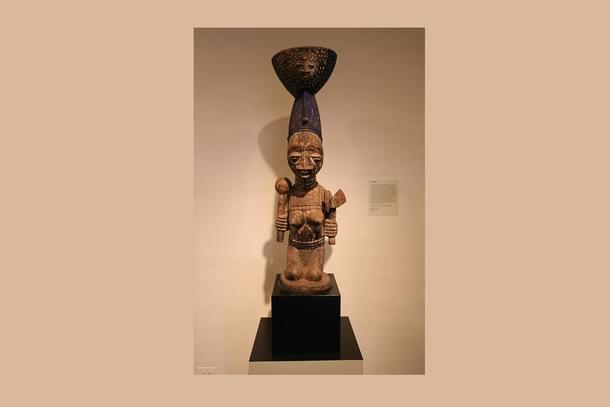
For Africa’s Yoruba people, She is Oshun. Her name means the Source.
She is also a river – which runs mainly in Nigeria. The main festival and reverence of the river happens in a sacred place called Osogbo. It has a sacred grove and is venerated as the shrine of Oshun.
This is a dense forest area. Once upon a time not in the long distant past, just 400 years ago, the land of Yoruba people had a lot of sacred groves. Today the main sacred forest of Oshun is part of the original primary forest of Nigeria. According to UNESCO, this sacred forest of the river Goddess contains no less than 400 species of plants of which 200 are of medicinal value.

Every year in the period of July-August, a 12-day long pilgrimage-festival is celebrated in Oshun-Osogho. Long ago when the original settlers in the region came here searching for livelihood, unwittingly they transgressed into the sacred forest of the Goddess. Now their lives were in her hand. She spared them. In return She should be celebrated by the people through the pilgrimage festival.
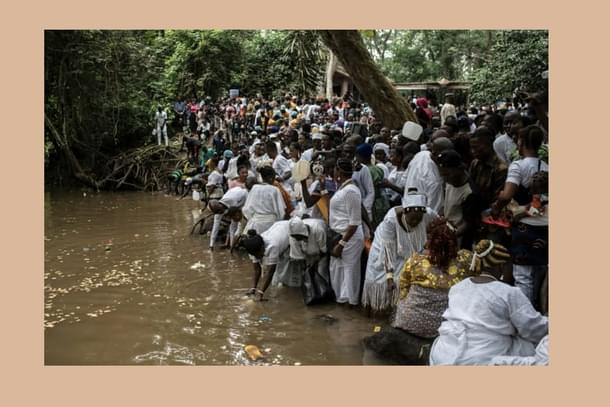
That is the traditional story behind the festival. The forest has many shrines. Artists belonging to the Yoruba culture, as well as those drawn to Yoruba spirituality, come here to create sculptures and offer their artworks.
The pilgrimage procession is be led by a virgin whose title is Arugba. The name means carrier of Calabash – bottle gourd shell containing the traditional offerings of the Goddess.
The festival brings together people, community leaders, priests and priestesses, artists and curious tourists as well as sincere seekers from outside the Yoruba people.
Goddess Oshun defies singular categories.
The River Goddess is a playful, vivacious meandering river. She is the mystic mirror that is self-knowledge. She is the wealth that is gold. She is the nourishment that is honey. She is the beauty that is peacock. She is the gestation that is fundamental to survival of the species. She is divine wisdom of the matriarch. She is the power of sex that a maiden holds. She is the promise of mystic experience and very material prosperity of worldly ambitions. She takes the form of a person or a process that is most suitable to the spiritual and earthly sustenance of Her devotees who become Her children.
When She is Yeye Saroda, She nourishes. When She is Yeye Kari She destroys as the raging flood. She is the subterranean sweet water that gushes forth when the ground is dug.
Oshun, the river Goddess married Orunmila, the deity of wisdom. But She had no children. So She left him for another. However She still could not bear child. She returned to him and asked how to have Her own child. For this it was told that She should do a sacrifice that would bring children to the mothers of the world. She did. However She now also had to make sure that the women did not suffer in pain with children. Thus She became the protective Goddess. Her son Esu became the messenger of the Devas (called Orishas) of Yoruba Puranic world, very much like Narada.
She has five major forms. She is a playful young girl and manifests where the river meets the ocean. She is the serious woman and a diviner manifesting Herself in waterfalls. She is the powerful sorceress associated with vultures. She is the old woman who lives in the depth of the river. She is so old and so deep that the devotees ring a huge bell to make Her hear. She is the patroness of sexual act.
Yoruba old chants praise Her thus:
She is the wisdom of the forest;
She is the wisdom of the river ;
Where the doctor failed She cures with fresh water.
Where medicine is impotent She cures with cool water
Among those African ethnicities who were torn from Africa through transatlantic slave trade many men and women were Yoruba. Toiling in the cotton fields and plantations, enduring all the tyrannies of slavery, Yoruba carried in their heart the Goddess Oshun. They built for Her shrines. Even when most were converted to Christianity, with them mostly having no say and with their ‘superstitions’ banned, the Goddess was worshipped underground. She became a hidden yet perennial stream.
Her Shrines came up in United States, Cuba, Trinidad, Brazil and Rio de Janeiro. She became the spiritual resistance to the religion imposed on the African-Americans and She became the spiritual sustenance during the darkest hours of slavery.
One very important aspect of Oshun worship is that any flowing river irrespective of the land becomes Oshun. Thus shrines today exist whether it is New York or Havana. Offerings and rituals are made by the devotees.
Oshun, Mississippi, Saraswati and Mark Twain
There exists a profound possibility that Oshun, the divine river Goddess, subtly graced one of the foundational texts of American literature—Huckleberry Finn.
Those who have journeyed through Samuel Clemens’ (Mark Twain) novel, would recognise the river as more than a mere backdrop; it is a living, breathing entity. In fact more than a living entity, it has a sacred presence.
Huck Finn, with his untainted heart, seems to become a vessel. Unwittingly, Mark Twain unveiled a glimpse of the sacred process by which a pure soul becomes a Mantra-Drashta—a perceiver of an eternal truth- Sanatana Satya- through the Spirit of the River.
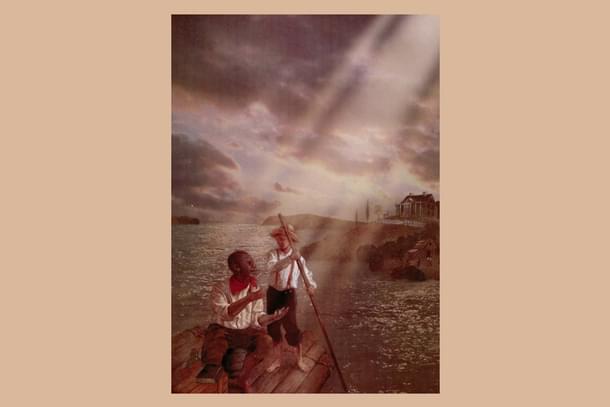
In an extraordinarily perspective essay on Huckle Berry Finn written in 1948, Lionel Trilling (1905-1975), a great literary critic pointed out this aspect of river and the hero of pure heart:
Huckleberry Finn is a great book because it is about a god— about, that is, a power which seems to have a mind and will of its own, and which to men of moral imagination appears to embody a great moral idea. Huck him self is the servant of the river-god, and he comes very close to being aware of the divine nature of the being he serves. The world he inhabits is perfectly equipped to accommodate a deity, for it is full of presences and meanings which it conveys by natural signs and also by preternatural omens and taboos... The river itself is only divine; it is not ethical and good. But its nature seems to foster the goodness of those who love it and try to fit themselves to its ways.Huckleberry Finn (Introduction), 1948: Liberal Imagination, 1953, p.103
Perhaps it is the strong Western cultural imprint that Trilling sees the river as a ‘god’ rather than a ‘Goddess’. In fact the river-god imagery comes to him from the line of a T.S.Eliot poem which meditates upon Missisipi as a ‘strong brown god’. Yet the following lines of Trilling, should naturally bring to Hindu mind, a striking connection with another riverine Goddess who is also the Goddess of wisdom:
(Huck) lives in a perpetual adoration of the Mississippi’s power and charm. Huck, of course, always expresses himself better than he can know, but nothing draws upon his gift of speech like his response to his deity. After every sally into the social life of the shore, he returns to the river with relief and thanksgiving; and at each return, regular and explicit as a chorus in a Greek tragedy, there is a hymn of praise to the god’s beauty, mystery, and strength, and to his noble grandeur in contrast with the pettiness of men.ibid.
Though rooted in the literary heritage of the West, Trilling connects the adored river deity with bringing forth the 'gift of speech' from the inner depths of the devotee. A Hindu knows what is happening here – Mississippi becomes a Saraswati.
What if Huckleberry Finn became more attuned to the sacred power of the river because of that black runaway slave Jim, whom Huckleberry Finn helps? Trilling writes that ‘the boy and the Negro slave form a family, a primitive community—and it is a community of saints.’
Perhaps the Deity of this 'community of saints' was the river?
Perhaps Jim was a Yoruba and though quasi-converted, had in him the religion of Oshun – whom he felt, even unknown to himself, in the flowing Mississippi?
More importantly, what if the sacred reverence for the river, present in the beliefs, night tales, and sacred songs sung in sorrowful tones by Afro-Americans, actually influenced Mark Twain himself, perhaps unconsciously and in mysterious ways? After all every summer Mark Twain family used to stay in a farm house where the cook was an African-American woman. Perhaps she was a Yoruba? It is merely a speculation about two fictional characters, yet their portrayal carries the power to add a mythological dimension to them.
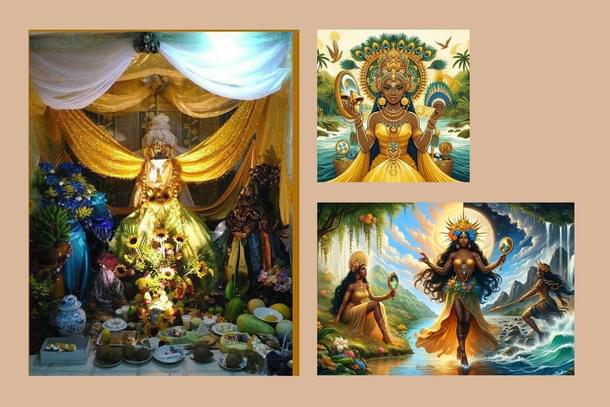
Oshun is thus every river Goddess. She is Saraswati. She is Ganga. She is Nile. She is Euphrates. She is Mississippi.
In the embrace of Goddess Oshun and Her rich traditions, Hindus find a profound resonance with their own Rig Vedic Nathi Sukta.
The sacredness of a river transcends its physical boundaries, becoming a universal manifestation of divine power. It is through the pure, poetic soul of a kavi-hearted rishi, that this sacredness is truly recognized, no matter where in the world it flows.
Every river embodies the essence of a Goddess, yet there are River Goddesses who await the rishi-kavi to converse with them so that through them the spiritual blessings can flow into humanity. This universal recognition of sacred rivers invites us to see the divine in every flowing stream, fostering a deeper, more mystical connection with the natural world.
Also read:
1. Navratri notes: Nammu, the forgotten Serpent-Sea Goddess from Sumeria
2. Navratri notes: Inanna, the Goddess of Life and War
3. Navratri notes: Maat, the Goddess of Cosmic Order, Breath of Life, and Justice
4. Navratri notes: Artemis, The Goddess of Wild Life and Child Birth





